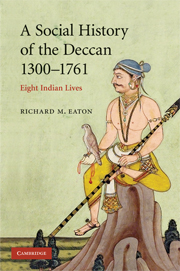Book contents
- Frontmatter
- Introduction
- 1 Pratapa Rudra (R. 1289–1323): the demise of the regional kingdom
- 2 Muhammad Gisu Daraz (1321–1422): Muslim piety and state authority
- 3 Mahmud Gawan (1411–1481): Deccanis and Westerners
- 4 Rama Raya (1484–1565): élite mobility in a Persianized world
- 5 Malik Ambar (1548–1626): the rise and fall of military slavery
- 6 Tukaram (1608–1649): non-brahmin religious movements
- 7 Papadu (fl. 1695–1710): social banditry in Mughal Telangana
- 8 Tarabai (1675–1761): the rise of Brahmins in politics
- Select bibliography
- Index
- Plate Section"
- References
3 - Mahmud Gawan (1411–1481): Deccanis and Westerners
Published online by Cambridge University Press: 28 March 2008
- Frontmatter
- Introduction
- 1 Pratapa Rudra (R. 1289–1323): the demise of the regional kingdom
- 2 Muhammad Gisu Daraz (1321–1422): Muslim piety and state authority
- 3 Mahmud Gawan (1411–1481): Deccanis and Westerners
- 4 Rama Raya (1484–1565): élite mobility in a Persianized world
- 5 Malik Ambar (1548–1626): the rise and fall of military slavery
- 6 Tukaram (1608–1649): non-brahmin religious movements
- 7 Papadu (fl. 1695–1710): social banditry in Mughal Telangana
- 8 Tarabai (1675–1761): the rise of Brahmins in politics
- Select bibliography
- Index
- Plate Section"
- References
Summary
The sultan [Ahmad Bahmani II, r. 1436–58] . . . ordered that, both at court and in cavalry formation, the Westerners should appear on the right side, while the Deccanis and Ethiopians should be on the left. From that time to the present, an inveterate hostility has taken hold between the Deccanis and Westerners, and whenever they get the chance, the former have engaged in killing the latter.
Muhammad Qasim Firishta (d. 1611)BY THE DOCKS OF DABHOL, 1453
Sometime in 1453, the same year that the Ottoman conquest of Constantinople carried Persian civilization to the frontiers of Europe, a high-born Iranian merchant named Mahmud Gawan stepped onto India's western shores. Then forty-two years of age, Gawan arrived aboard a merchant ship that had sailed down the Persian Gulf and across the Arabian Sea, docking at Dabhol on the Konkan coast. The ports of Chaul and Dabhol, located respectively some twenty and eighty-five miles south of modern Mumbai, were the Bahmani sultanate's two principal windows on the wider world to the west (see Map 3). For the next several centuries, the two ports would link states of the Deccan ever more tightly with that world–a world permeated with Persian art, thought, cuisine, language, literature, dress, styles of piety, and models of comportment. Hailing from an aristocratic family of northern Iran, Gawan himself represented the most refined and cosmopolitan vision of contemporary Persian culture.
From the docks of Dabhol, Gawan oversaw the off-loading of the consignments he had brought with him from Iran to India: silken fabrics, Turkish and Ethiopian slaves, pearls, jewels, and Arabian horses. He knew that all of these goods, especially the last, would fetch fine prices along the ports of the Konkan coast. From these ports, caravans would wend their way up the narrow defiles of the Sahyadri Mountains and carry goods like his to the markets and urban centers of the Deccan plateau. Heavy warhorses were in special demand, since in the Deccan, as in India generally, state power rested ultimately on units of mounted archers.
- Type
- Chapter
- Information
- A Social History of the Deccan, 1300–1761Eight Indian Lives, pp. 59 - 77Publisher: Cambridge University PressPrint publication year: 2005
References
- 2
- Cited by



